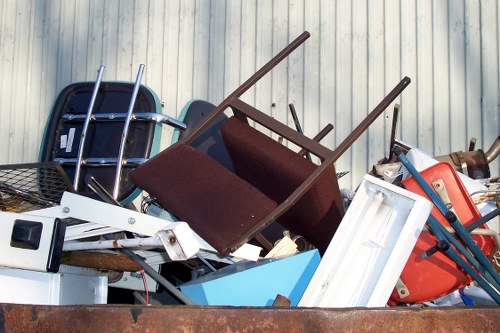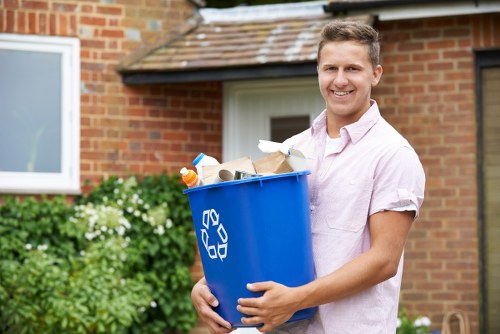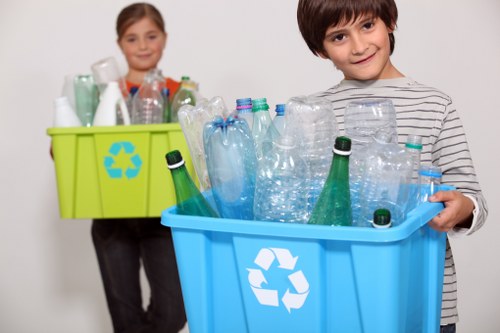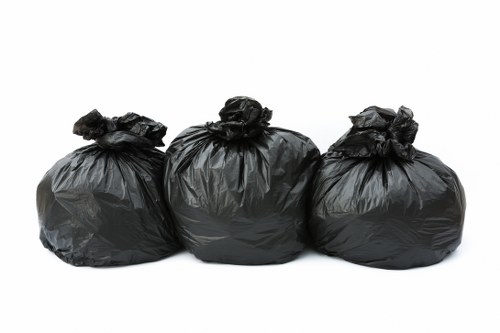Comprehensive Guide to Construction Waste Clearance in Southfields
Understanding Construction Waste Clearance

Construction projects inevitably generate a significant amount of waste. Effective construction waste clearance is essential to maintain a clean and safe work environment. In Southfields, professionals and homeowners alike are recognizing the importance of proper waste management to ensure projects run smoothly and sustainably.
Whether you're undertaking a major renovation or a small-scale construction project, knowing how to handle construction debris can save you time, money, and environmental resources. This article explores the various aspects of construction waste clearance in Southfields, providing valuable insights and practical tips for efficient waste management.
From understanding the types of construction waste to choosing the right disposal methods, we'll cover everything you need to know to keep your project on track and environmentally friendly.
The Importance of Construction Waste Clearance

Effective waste clearance is not just about maintaining aesthetics; it's a crucial component of project management. Proper disposal of construction waste can:
- Enhance site safety by reducing hazards.
- Prevent environmental pollution by ensuring materials are recycled or disposed of responsibly.
- Comply with local regulations and avoid potential fines.
- Improve project efficiency by freeing up space for ongoing work.
In Southfields, where construction activity is vibrant, adhering to waste clearance best practices helps in sustaining the neighborhood's appeal and environmental standards.
Types of Construction Waste

Understanding the different types of construction waste is the first step toward effective clearance. The main categories include:
- Concrete and Masonry: Includes bricks, blocks, and concrete remnants.
- Wood: Includes timber, plywood, and engineered wood products.
- Metals: Such as steel, aluminum, and copper.
- Plastics: Includes PVC, insulation material, and other plastic-based products.
- Drywall: Sheets of plasterboard and related materials.
Each type requires specific disposal methods to ensure they are handled appropriately, minimizing environmental impact.
Regulations and Compliance in Southfields

Southfields has established stringent regulations governing construction waste management to promote environmental sustainability and public safety. Compliance involves:
- Proper segregation of waste at the source.
- Selecting licensed waste carriers.
- Ensuring timely removal and documentation of waste disposal.
- Adhering to recycling and reuse guidelines.
Non-compliance can result in hefty fines and project delays, making it imperative to stay informed about local laws and regulations related to construction waste clearance.
Methods of Construction Waste Clearance

Efficient waste clearance involves several methods tailored to the type and volume of waste generated:
1. Recycling
Recycling is a sustainable approach that involves processing waste materials into new products. Materials like metals, wood, and certain plastics can be effectively recycled, reducing the need for raw materials.
2. Reuse
Some construction materials can be repurposed for other projects. Reusing items like bricks, timber, and fixtures not only saves costs but also minimizes waste.
3. Landfilling
For non-recyclable and non-reusable waste, landfilling remains a viable option. It is essential to ensure that waste is disposed of in designated landfills to prevent environmental contamination.
4. Specialized Disposal
Certain materials, such as asbestos or hazardous chemicals, require specialized disposal methods to mitigate health risks and environmental impact.
Selecting a Waste Clearance Service
Choosing the right waste clearance service in Southfields is crucial for the success of your construction project. Consider the following factors:
- Licensing and Certification: Ensure the service provider is licensed and complies with local regulations.
- Recycling Practices: Opt for companies that prioritize recycling and sustainable disposal methods.
- Timeliness: Prompt waste removal helps maintain project momentum.
- Cost: Compare pricing structures to find a service that fits your budget without compromising quality.
- Customer Reviews: Assess the reputation of the service provider through customer feedback.
Benefits of Hiring Professional Services
Professional waste clearance services offer expertise and resources that enhance the efficiency and effectiveness of waste management. They handle the logistics of waste removal, ensuring that materials are disposed of correctly and responsibly.
Cost Considerations

The cost of construction waste clearance in Southfields can vary based on several factors:
- Volume of Waste: More waste typically leads to higher disposal fees.
- Type of Materials: Specialized disposal for hazardous materials can incur additional costs.
- Service Frequency: Regular clearance services might offer discounted rates compared to one-time pickups.
- Location: Accessibility and distance from waste processing facilities can affect pricing.
It's advisable to obtain multiple quotes and understand the pricing structure to make an informed decision that aligns with your project budget.
Environmental Impact of Construction Waste

Construction waste has a significant impact on the environment if not managed properly. Proper clearance practices contribute to:
- Reduced Landfill Use: Recycling and reusing materials decrease the burden on landfills.
- Energy Conservation: Recycling certain materials, like metals, requires less energy compared to producing them from raw resources.
- Pollution Prevention: Proper disposal prevents pollutants from entering soil and water systems.
- Resource Efficiency: Maximizing the use of existing materials supports sustainable construction practices.
By embracing responsible waste management, Southfields can foster a healthier and more sustainable environment for its residents.
Innovations in Waste Clearance
The field of construction waste management is evolving with innovative solutions aimed at enhancing efficiency and sustainability:
1. Waste Tracking Software
Advanced software solutions help in tracking waste generation, segregation, and disposal, providing real-time data to optimize waste management processes.
2. On-Site Sorting Facilities
Establishing on-site sorting facilities allows for immediate segregation of waste, facilitating easier recycling and reducing contamination risks.
3. Sustainable Materials
The use of eco-friendly building materials that produce less waste contributes to more sustainable construction practices.
4. Robotics and Automation
Automated systems for sorting and processing waste can significantly enhance the speed and accuracy of waste clearance operations.
Adopting these innovations can lead to more effective and environmentally responsible construction waste management in Southfields.
Best Practices for Construction Waste Clearance

Implementing best practices ensures that construction waste clearance is handled efficiently and responsibly:
- Plan Ahead: Develop a waste management plan at the outset of your project.
- Educate the Team: Ensure that all team members understand waste segregation and disposal procedures.
- Monitor Progress: Regularly assess waste generation and clearance to identify areas for improvement.
- Partner with Reputable Services: Collaborate with waste clearance companies that prioritize sustainability and compliance.
- Document Waste Handling: Keep records of waste disposal methods for compliance and auditing purposes.
Following these practices not only promotes efficiency but also contributes to a greener and safer construction environment.
Challenges in Construction Waste Clearance

Despite the benefits, several challenges can hinder effective construction waste management:
1. Lack of Awareness
Many contractors and workers may not be fully informed about proper waste management practices, leading to improper disposal.
2. Resource Limitations
Limited access to recycling facilities and waste processing centers can complicate waste clearance efforts.
3. Financial Constraints
Budget limitations may prevent the adoption of comprehensive waste management strategies, especially for smaller projects.
4. Regulatory Complexity
Navigating the myriad of local regulations and compliance requirements can be daunting and time-consuming.
Overcoming these challenges requires education, investment in resources, and collaboration with knowledgeable waste clearance partners.
Case Studies: Successful Waste Clearance in Southfields
Examining successful projects can provide valuable lessons for effective waste management. Here are a couple of examples:
- Residential Renovation: A local homeowner engaged a professional waste clearance service that sorted and recycled materials, significantly reducing landfill contributions and lowering overall project costs.
- Commercial Construction: A commercial developer implemented an on-site sorting system and partnered with a recycling facility, achieving compliance with regulations and enhancing the project's sustainability profile.
These case studies highlight the benefits of strategic waste clearance planning and the positive outcomes of responsible waste management.
Future Trends in Construction Waste Clearance
The future of construction waste management is poised for significant advancements, driven by sustainability goals and technological innovations:
- Circular Economy: Emphasizing the reuse and recycling of materials to create a closed-loop system.
- Advanced Recycling Technologies: Development of new methods to recycle complex materials more efficiently.
- Smart Waste Management Systems: Integration of IoT and AI to optimize waste collection and processing.
- Green Certification: Increasing demand for construction projects to achieve environmental certifications, encouraging better waste management practices.
Staying abreast of these trends will help construction professionals in Southfields adopt cutting-edge waste clearance strategies, ensuring sustainable and efficient project outcomes.
How to Get Started with Construction Waste Clearance
Initiating an effective waste management plan involves several steps:
- Assess Your Needs: Determine the volume and types of waste your project will generate.
- Develop a Plan: Create a comprehensive waste management strategy outlining segregation, disposal, and recycling methods.
- Select a Service Provider: Choose a reputable waste clearance company that aligns with your project's requirements and sustainability goals.
- Implement the Plan: Educate your team, set up waste sorting stations, and commence regular waste removal.
- Monitor and Adjust: Continuously evaluate the effectiveness of your waste management practices and make necessary adjustments.
By following these steps, you can establish a robust construction waste clearance system that supports both project success and environmental stewardship.
Ready to streamline your construction waste clearance?
Contact us today to learn how our expert services can help you manage construction waste efficiently and sustainably in Southfields.
Benefits of Sustainable Waste Clearance

Adopting sustainable waste clearance practices offers numerous advantages:
- Environmental Preservation: Reducing landfill use and promoting recycling helps protect natural resources.
- Cost Savings: Efficient waste management can lower disposal costs and potentially generate revenue through recycling.
- Enhanced Reputation: Demonstrating a commitment to sustainability can improve your company's public image and attract eco-conscious clients.
- Regulatory Compliance: Staying compliant with environmental laws helps avoid penalties and ensures smooth project operations.
Embracing sustainable practices in construction waste clearance not only benefits the environment but also contributes to the overall success and reputation of your construction endeavors in Southfields.
Choosing the Right Equipment for Waste Clearance
Using the appropriate equipment is essential for efficient construction waste clearance. Key equipment includes:
- Skip Bins: Available in various sizes to accommodate different volumes of waste.
- Compactors: Help reduce the volume of waste, making transportation more efficient.
- Sorting Tables: Facilitate the separation of recyclable and non-recyclable materials on-site.
- Safety Gear: Ensures the safety of workers handling waste materials.
Investing in the right equipment enhances the effectiveness of your waste clearance operations, ensuring that waste is managed safely and efficiently.
Training and Education for Effective Waste Management
Proper training and education are critical for successful construction waste clearance:
- Waste Segregation Training: Educate workers on how to separate different types of waste correctly.
- Safety Protocols: Train staff on the safe handling and disposal of hazardous materials.
- Environmental Awareness: Promote understanding of the environmental impact of construction waste.
- Regulatory Compliance: Ensure that all team members are aware of and adhere to local waste management laws and guidelines.
Investing in training programs leads to more effective and responsible waste management practices, contributing to the overall success and sustainability of your construction projects in Southfields.
Empower your team with the knowledge they need
Book your service now and ensure your construction waste is managed by professionals committed to sustainability and efficiency.
Conclusion
Effective construction waste clearance in Southfields is a vital component of any construction project. By understanding the types of waste, adhering to regulations, selecting the right clearance methods, and embracing sustainable practices, you can ensure that your project is not only successful but also environmentally responsible.
Partnering with experienced waste clearance services, investing in the right equipment, and educating your team are essential steps toward achieving efficient waste management. As the construction industry continues to evolve, staying informed about the latest trends and innovations in waste clearance will help you maintain a competitive edge and contribute to a greener Southfields.
Don't let construction waste hold your project back. Contact us today to discover how our expert waste clearance solutions can support your construction needs and promote sustainability.